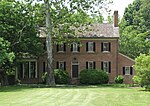Spotsylvania Courthouse, Virginia

Spotsylvania Courthouse is a census-designated place (CDP) and the county seat of Spotsylvania County, Virginia, United States, located 10 miles (16 km) southwest of Fredericksburg. Recognized by the U.S. Census Bureau as a census designated place (CDP), the population was 4,239 at the 2010 census. During the American Civil War, the crossroads community became a Union objective during the Battle of Spotsylvania Courthouse, fought May 8–21, 1864. The battle, which ended in stalemate, included a brutal 20-hour struggle over a section of the Confederate defenses that became known as the "Bloody Angle". The site of the Bloody Angle and other portions of the battlefield are preserved as part of Fredericksburg and Spotsylvania County Battlefields Memorial National Military Park and administered by the National Park Service. The Fredericksburg and Spotsylvania National Military Park includes three cemeteries. Over 15,000 Union soldiers, many unidentified, are buried in the Fredericksburg National Cemetery. The other two cemeteries are dedicated to fallen Confederate soldiers.
Excerpt from the Wikipedia article Spotsylvania Courthouse, Virginia (License: CC BY-SA 3.0, Authors, Images).Spotsylvania Courthouse, Virginia
Courthouse Road,
Geographical coordinates (GPS) Address Nearby Places Show on map
Geographical coordinates (GPS)
| Latitude | Longitude |
|---|---|
| N 38.201944444444 ° | E -77.5875 ° |
Address
Spotsylvania County Judicial Center
Courthouse Road 9111 -9115
22553
Virginia, United States
Open on Google Maps








